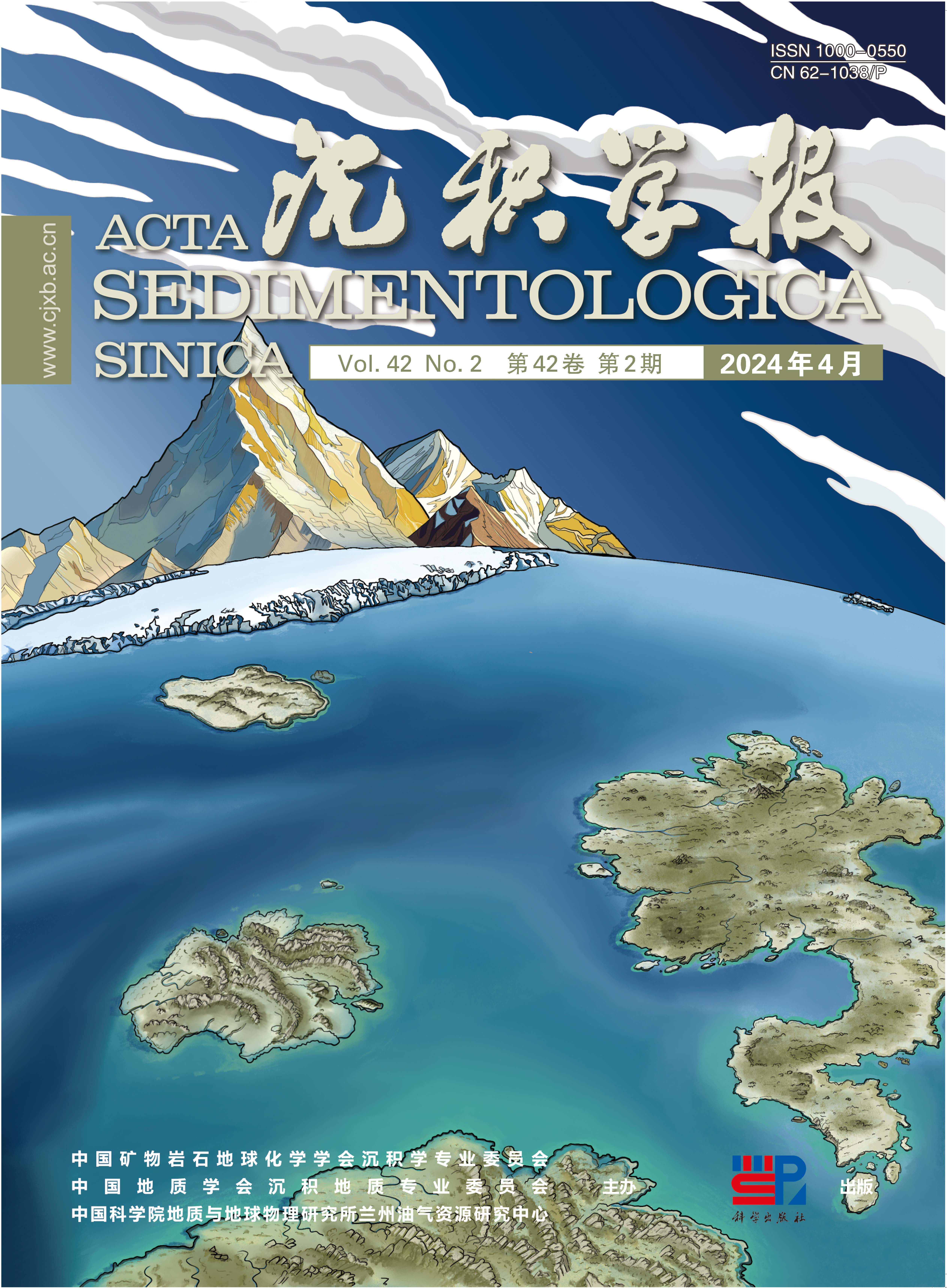HTML
-
我国黄土沉积分布广泛,黄土沉积中蕴含着丰富的环境变化信息,记录了古气候和古环境的变迁[1⁃7]。粒度作为黄土沉积的一项基本特征,受到沉积物源、搬运动力和沉积环境等因素影响,是古环境研究的重要指标,对重塑古环境演化过程、揭示古气候变化具有重要作用[8⁃15]。通过对黄土粒度的研究,可以分析黄土沉积的搬运动力特征、传输途径和源区范围等,进而表征季风变化[16⁃23]。黄土沉积的不同粒级对环境变化的敏感程度不同[24],因此依托粒度特征的精细解构,提取黄土沉积的敏感粒级组分开展物源追踪、古环境重建也显得更加重要。粒度端元分析技术就是其中的重要部分,粒度端元分析模型[25]可以分离不同沉积动力作用下的沉积物粒度组分,揭示沉积动力组合和物源信息,进而提取敏感粒级组分反演环境变迁,该技术已在黄土研究中取得系列成果[26⁃31]。
末次冰期以来,长江三角洲平原以及东海海域广泛存在风尘黄土沉积,对晚更新世以来长江三角洲及东海岛屿黄土沉积的相关研究,也成为反演末次冰期以来我国东部季风区古环境变迁和古气候变化的重要内容[32⁃35]。与西部黄土相比,东海岛屿黄土沉积的厚度较小[32],黄土沉积除接受西北内陆远源风尘物质外,来自东海陆架的近源风尘物质对岛屿黄土沉积也有一定贡献[36⁃37]。对东海嵊山岛黄土沉积物源、沉积动力和沉积区域环境演变的研究,一直是东海岛屿黄土研究的重要内容。通过粒度端元分析方法对东海岛屿黄土沉积过程研究,有利于深入分析嵊山岛黄土沉积动力组合特征、判别物源信息变化,对末次冰期以来我国季风区东海岛屿黄土沉积区域古气候演变研究具有重要意义。本研究以位于我国季风区风尘堆积东缘的典型东海岛屿风尘黄土堆积剖面(嵊山岛黄土)为对象,聚焦剖面风尘黄土样品中的粒度特征,在端元分析方法基础上结合年代学、环境磁学等指标,探讨东海嵊山岛黄土的沉积动力特征和区域古环境演变信息。
-
嵊山岛位于浙江沿海舟山群岛外缘区域,处于东海马鞍列岛核心位置,隶属舟山市嵊泗县(图1)。嵊山岛属浙江东部天台山脉东延伸,地势东部高西南低,岛屿面积约4.22 km2,海岸线总长度约19.26 km,地貌类型多低山丘陵。该区域位于东亚季风区的东缘,气候属北亚热带海洋季风气候,受海洋气流作用明显,夏季盛行东南风,高温多雨;冬季盛行西北风,低温干燥,年均气温15 °C~17 °C,降水量达1 072 mm,嵊山岛最高峰为陈钱山,海拔约213 m[38]。嵊山岛主要由花岗岩组成,大部分区域基岩直接出露地表,在岛屿的山坡、山谷以及低洼地带形成第四纪松散堆积物,片状黄土覆盖在基岩山坡上,并随岛屿地势起伏而变化[39]。嵊山岛黄土沉积也是开展我国东亚季风区域古环境变化研究的重要载体[32]。
所选黄土剖面位于舟山群岛东北缘嵊山岛的陈钱山东北坡位置(30.730° N,122.817° E),海拔约150 m(图2)。剖面整体呈黄棕色和黄褐色,剖面黄土颗粒较细,无明显层理,沉积剖面上未见花岗岩风化残留物。剖面上部30 cm多植物根系,顶部10 cm土质较为疏松受人为活动影响较大,整个剖面深度约280 cm,剖面底部为花岗岩基岩风化壳,可见部分花岗岩风化颗粒与黄土沉积相混合,黄土沉积剖面底部与该花岗岩风化壳呈不整合接触关系。综合该研究区域的地形地貌和黄土沉积的剖面信息,可知该研究剖面为东海嵊山岛一处典型的风尘堆积。为获取高分辨率古环境信息,同时考虑到人为活动影响,由地表以下5 cm至275 cm剖面深度以1 cm为间隔获取黄土沉积样品。
-
本次研究共获取样品271个。将野外采集的样品按照样品编号置于30 ℃烘箱内烘干,对经恒温烘干后的样品进行有机质和碳酸盐的去除。首先,称取0.1 g的黄土沉积样品置于烧杯中,加入5%的双氧水5 mL,并加热煮沸使其充分反应,静置冷却后再加入0.2 mol/L的盐酸并加热煮沸,充分反应冷却后,再注入适量去离子水静置24 h。静置后的样品溶液,去除去离子水并加入0.05 mol/L的六偏磷酸钠试剂后进行超声震荡,经10~15 min的充分震荡使样品分散,冷却后用于粒度的测定。样品的粒度测试在华东师范大学地理科学学院全球环境变化实验室进行,采用Mastersizer2000 激光粒度仪进行测定,测试范围在0.02~2 000 μm,测试误差小于2%。
-
在沉积剖面10 cm、100 cm、150 cm和250 cm深度取样,在暗室红光条件下完成样品前处理,取出采集的样品,除去两端可能曝光部分,剩余样品依次使用30%双氧水和10%的盐酸去除样品中有机质和碳酸盐,经过湿筛和去除重矿物,以及氢氟酸刻蚀等步骤,获得测年所需石英颗粒。采样管两端样品用于U、Th、K以及含水量指标测定,利用单片再生剂量法(Single Aliquot Regenerative-dose,SAR)完成所提取石英等效剂量De测定[40]。样品含水量为实测含水量,样品的U、Th、K含量以中子活化法(NAA)测试,样品光释光年代测量在南京大学地理与海洋科学学院光释光测年实验室完成。
-
将所采集样品置于35 ℃的烘箱内恒温烘干。称取7 g烘干的样品用塑料保鲜膜包起来,装入体积为10 mL的磁学专用塑料盒中,使用华东师范大学河口海岸学国家重点实验室英国制造的Bartington双频磁化率仪MS2进行磁化率的测定。分别对样品低频质量磁化率(χlf)和高频质量磁化率(χhf)进行测定,并计算百分频率磁化率(χfd%),计算公式为:χfd%=(χlf-χhf)/χlf×100%。
-
将采集黄土样品置于玛瑙研磨碗中研磨后过50 μm筛。称取约5 g研磨后的过筛样品倒入直径约4 cm、厚约0.5 cm的圆形模具中央,将样品送至压样机压制。压样机加压并保持在37.5 t/M2约30 s后,自然泄压,待测样品制备完成。将制作好的样品置于X荧光光谱仪(XRF)(日本)进行测试,完成所需Rb、Sr等元素测定,测试过程中使用GSD-9标准物质进行质量控制,样品分析误差小于5%。
-
端元分析可以把粒度数据分解为多个端元,并认为不同的端元是由不同物源在特定的动力机制和沉积环境下分选而来[25]。本研究采用Paterson端元分析软件[41],在MATLAB R2019环境下加载Analysize-Masters程序,在假定1~10个端元前提下,分别通过程序中非参数化选项和参数化选项(在参数化分析选项下选择Gen.Weibull分布函数),对嵊山岛黄土沉积剖面粒度数据进行端元分析。
2.1. 粒度测试
2.2. 光释光年代测试
2.3. 磁学参数测试
2.4. 铷、锶元素测试
2.5. 粒度端元分析
-
嵊山岛黄土沉积在剖面深度10 cm、100 cm、150 cm和250 cm处光释光年代测试结果分别为0.4±0.1 ka、35.03±3 ka、42.41±4 ka和51.67±4 ka(表1)。嵊山岛黄土沉积的采样剖面质地均一,未发现明显的地层倒置情况,结合光释光年代测定结果,嵊山岛黄土堆积于末次冰期时期。
剖面 深度/cm U/(μg/g) Th/(μg/g) K/% 实测含水量/% 环境剂量率/(Gy/ka) 等效剂量/Gy 年龄/ka 嵊山岛屿剖面 10 2.83 14.3 1.49 14.45 3.05 1.2±0.3 0.40±0.1 100 2.98 15.1 1.69 11.86 3.34 117±4 35.03±3 150 2.94 14.4 1.56 8.18 3.23 137±8 42.41±4 250 2.93 14.3 1.62 16.49 3.00 152±5 51.67±4 Table 1. OSL dating results of Shengshan Island loess profile
-
选取嵊山岛黄土剖面20 cm、30 cm、50 cm、100 cm、150 cm、200 cm、250 cm深度样品粒度频率分布曲线为典型代表(图3a):不同深度样品粒度频率分布曲线特征基本一致,剖面粒度频率曲线呈现显著的“三峰”分布特征;第一众数组粒径主要集中在16~36 μm,第一众数组粒径向粗粒端减少较快,向细粒端减少较缓慢,指示较弱的搬运动力条件下粗粒物质堆积较少;第一众数组在向细粒端减少过程中,在3~10 μm出现第二众数组,该众数组颗粒较细,粒度均小于20 μm,是通过风力悬浮搬运的重要组分;在0.2~2 μm出现第三众数组,成为剖面的超细粒组分,黄土高原黄土和古土壤中也普遍存在超细粒组分,该超细颗粒组分一定程度上与成壤作用有关[42]。根据粒度分析结果,嵊山岛黄土剖面黏土(小于5 μm)含量为26.45%,细粉砂含量(5~16 μm)32.25%,中粉砂含量(16~32 μm)25.24%,粗粉砂含量(32~63 μm)14.37%,砂(大于63 μm)含量均值为1.69%。根据谢帕德三角分类法在沉积物分类研究中的应用,对嵊山岛黄土沉积剖面粒度特征进行分类(图3b),嵊山岛黄土沉积粒径集中分布在粉砂和黏土质粉砂中,黄土沉积颗粒整体较细,结合黄土剖面粒度分布频率曲线,黄土沉积以粉砂级粒径为主,这也反映嵊山岛黄土属风尘堆积。
-
基于Analysize-Masters的粒度端元分析程序,对嵊山岛黄土沉积样品粒度数据进行非参数化和参数化端元分析,并在此基础上,确定嵊山岛黄土沉积粒度端元。根据以下原则确定粒度端元[29,43],在最优端元确定过程中体现粒度数据集和端元总体相关度的线性相关系数应大于0.9,以达到最优拟合效果;体现粒度曲线与端元拟合形状误差的角度偏差值应越小越好,当角度偏差在5度以下,满足端元曲线形状拟合要求,同时体现各个端元独立性的端元相关度应尽量的小,端元相关度大说明端元之间分布重合,存在过度拟合情况,在分析中满足以上拟合原则基础上,尽量选择少的端元数量。
通过综合比较参数化和非参数化端元分析结果,确定嵊山岛黄土剖面粒度端元。非参数化端元模型分析显示当端元数大于等于2时,角度偏差均小于5°,线性相关系数均在0.9以上,端元相关系数波动上升。根据角度偏差小于5°,线性相关系数大于0.9,端元数和端元相关系数取小原则,非参数化模型分解端元数应取2,此时线性相关系数为0.993,角度偏差为4°,端元相关度为0.499(图4a,b)。通过参数化端元模型分析,当端元数大于等于3时,角度偏差、线性相关度满足要求,端元相关度有所波动。按照端元数确定原则,在参数化分析条件下,分解端元数取3,线性相关度为0.995,角度偏差为3.1°,端元相关度为0.045(图4c,d)。此时参数化端元分解的线性相关度好于非参数化分解结果,同时角度偏差和端元相关度也均小于非参数化分析结果,故应对嵊山岛黄土剖面粒度选择参数化端元分解方法,最终确定3个端元进行深入分析。
参数化端元分解的端元粒度频率分布曲线显示(图5),EM1的众数粒径为3.88 μm,是黄土剖面细粒端元,处于黏土粒级范围;EM2的众数粒径为11.25 μm,处于细粉砂粒级范围;EM3的众数粒径为31.70 μm,属中粉砂向粗粉砂过渡范围。3个端元粒度组分特征显示(表2),EM1、EM2、EM3平均粒径分别为3.38 μm、10.44 μm和30.56 μm,和每个端元的众数粒径较为一致。3个分解端元粒度频率分布特征均为单峰分布,EM1、EM3呈正偏特征,EM2呈负偏特征。随着端元粒度组分粒径的增大,峰态呈现高和窄的特征,分选性增强,细粒端元EM1峰态相对宽平,峰值较低,分选较差,EM2、EM3峰态高窄,峰值陡峭,分选性增强。
端元 粒度 平均粒径/MZ 分选系数/σ 偏度/SKI 峰态/KG EM1 3.38 μm 3.24 0.63 3.24 EM2 10.44 μm 2.19 -0.13 2.77 EM3 30.56 μm 1.61 0.04 2.71 Table 2. Distribution of end⁃member particle size
-
EM1众数粒径为3.88 μm,处于黏粒级范畴,沉积剖面该组分含量范围0.32%~40.63%,平均含量25.00%。黄土沉积中黏粒组分受到成壤作用影响,相关研究显示风化成壤作用产生的细粒组分粒径小于1 μm[44],EM1端元中大于1 μm组分约占87%(图6)。根据EM1与其他端元以及小于2 μm粒级含量关系(表3),EM1与EM2呈负相关,指示EM1也不是黏附于EM2搬运而来。通过对黄土高原黄土和长江中下游下蜀黄土粒度端元分解,显示均存在2~8 μm的众数粒径分布端元,并认为该端元组分可以代表高空西风气流传输的远源组分[45⁃46]。因此,嵊山岛黄土沉积EM1端元相对于黄土高原和下蜀黄土较为相似的端元组分和众数粒径,可以代表高空西风远源输送组分;同时EM1与小于2 μm粒级含量显著正相关,考虑黄土风化成壤作用影响的粒度组分多在2 μm以下,黏粒组分反映黄土堆积时较暖湿的气候条件[47],嵊山岛黄土剖面粒度端元EM1可能代表了高空西风输送的远源组分,该组分同时也可能受湿沉降的影响。
EM1 EM2 EM3 Md <2 μm EM1 1 EM2 -0.707** 1 EM3 -0.135* -0.797** 1 Md 0.020 -0.352** 0.476** 1 <2 μm 0.460** -0.407** 0.177** -0.273** 1 注: **置信度0.01水平下显著相关,*置信度0.05水平下显著相关。Table 3. Correlations between end⁃members, median grain size and <2 μm fractions
EM2众数粒径为11.25 μm,属于细粉砂粒级范畴,沉积剖面该组分含量范围31.92%~78.14%,平均含量为45.60%,占比较高。黄土沉积中平均粒径在20 μm以下的细粒组分,可以在高空气流作用下进行远距离悬浮搬运[48],也可以来自邻近粉尘源区,同时也可随浮尘作用过程以细颗粒物形式直接沉降[49]。根据EM2端元粒度频率累积曲线,该粒度端元中20 μm以下的细粒组分占比超过80%(图6),同时与EM1显著负相关,指示与剖面细粒组分传输方式的差异性,与EM3的显著负相关指示该组分同剖面中的粗粒组分传输方式也有不同,与沉积剖面中值粒径的显著负相关,也进一步揭示较强的风力作用可能对EM2端元组分沉积具有一定的阻滞作用。因此,嵊山岛黄土剖面粒度端元EM2可能代表了以浮尘形式搬运传输并随风力减弱而发生沉降的粒级组分。
EM3众数粒径为31.70 μm,基本属于粗粉砂粒级范畴,沉积剖面该组分含量范围2.10%~42.23%,平均含量为29.39%。黄土沉积中20~70 μm颗粒组分多伴随尘暴作用,以低空短距离悬移方式传输[50],相关研究显示20~100 μm颗粒组分为近地面短距离搬运组分,黄土中21~54 μm沉积组分也与冬季风强度呈正相关关系[51⁃52]。黄土粒度端元分解显示,37 μm颗粒组分为黄土高原冬季风搬运组分[53]。根据EM3端元粒度频率累积曲线,该粒度端元中20 μm以上的颗粒组分占比近80%(图6)。EM3端元组分颗粒较粗,从端元粒度频率分布曲线可以看出,粒度频率分布曲线峰值较高、峰区较窄,反映该端元组分搬运距离较小,距离物源较近。同时,EM3同沉积剖面中值粒径显著正相关,指示该端元组分也是冬季风变化的指示组分,推测嵊山岛黄土剖面EM3端元组分可能代表了冬季风驱动下的近地表短距离搬运沉积组分。
-
黄土沉积过程受沉积动力和沉积环境综合影响,黄土沉积中值粒径变化与沉积速率、古气候变化等关系密切[54⁃55],黄土粒度可以指示冬季风强度的变化[10]。频率磁化率反映沉积地层中超顺磁颗粒含量情况,进而指示沉积时古气候的温湿程度和持续时间[56]。同时,黄土沉积中元素比值可以作为古气候变化的代用指标,其中铷锶比值反映黄土沉积时段湿热条件,可以作为古季风气候要素中夏季风环流强度指标[57]。嵊山岛黄土剖面铷锶比值总体呈现随剖面深度减小,先波动降低,然后有所升高后再波动降低的变化特征。结合嵊山岛黄土沉积光释光年代测定结果,同时对比深海氧同位素记录和古海平面变迁情况[58⁃60],认为嵊山岛黄土剖面大体堆积于末次冰期阶段。在此基础上,对嵊山岛黄土沉积粒度端元所揭示的剖面沉积过程及其古环境意义进行综合分析(图7)。

Figure 7. Characteristics of end⁃member content, frequency dependent susceptibility, median size and Rb/Sr value
嵊山岛黄土沉积从剖面底部至75 cm深度附近,大体对应深海氧同位素MIS3阶段。该沉积时段,铷锶比值随剖面深度减小呈现波动减小后又波动上升的变化规律,剖面铷锶比(Rb/Sr)平均值为1.24,标准偏差0.06,存在高值波动区域。剖面百分频率磁化率(χfd%)平均值为11.17%,略高于剖面平均数值,标准偏差2.63。中值粒径(Md)平均值为13.91 μm,与剖面整体平均值相比变化不大,同时存在低数值波动区域,标准偏差1.59。该沉积时段,黄土沉积剖面EM1端元组分平均含量24.45%,标准偏差5.62,呈波动上升变化趋势并出现高值波动区域。EM3端元组分平均含量为29.75%,标准偏差6.07,存在明显的低数值波动区域,在一定程度上指示冬季风强度的减弱和尘暴活动的减少,EM2端元组分平均含量为45.83%,标准偏差8.72,存在高值波动区间,反映此沉积阶段冬季风活动强度的减弱,更多以浮尘形式搬运的EM2端元组分沉降堆积。黄土沉积的频率磁化率与东亚夏季风关系密切,也是古降水量的代用指标[61],铷锶比值反映风化成壤强度,记录夏季风环流强度[62]。剖面铷锶比值的高值波动,百分频率磁化率值的波动上升,以及EM3端元组分的低值波动和EM1端元组分的波动上升,一定程度上也指示了末次冰期间冰阶时期夏季风活动的增强和嵊山岛黄土沉积所经历的较暖湿的沉积环境。
结合沉积剖面铷锶比(Rr/Sr)、百分频率磁化率(χfd%)和中值粒径(Md)变化,对嵊山岛黄土剖面分离出的3个端元组分进一步分析。第一,从剖面底部275 cm至155 cm深度附近,大体对应MIS3c阶段。此时段深海氧同位素偏轻,古海平面上升,嵊山岛黄土沉积剖面铷锶比处于高值区域波动,平均值为1.27,标准偏差0.05,随剖面深度减小呈波动下降的趋势;百分频率磁化率处于高值波动区域,平均值为10.85%,标准偏差2.36,与此同时中值粒径平均值为13.45 μm,标准偏差1.58,更多在低值区域波动,铷锶比值和百分频率磁化率共同指示嵊山岛黄土沉积在MIS3c时段较暖湿的气候特征。该沉积时段,剖面EM1端元组分上升并在相对高值区间波动,此时代表冬季风活动强度的EM3端元组分出现低值波动区域,平均值为28.01%,标准偏差6.37,指示冬季风活动的减弱,这也使得浮尘形式传输的EM2端元组分沉降通量增加,出现高值波动,剖面平均含量达48.04%,标准偏差8.86。第二,从剖面深度155~100 cm,大体可以对应MIS3b阶段。此时段深海氧同位素偏重,古海平面下降,嵊山岛黄土剖面铷锶比值波动降低至低数值区间,平均值降至1.19,标准偏差0.04;百分频率磁化率平均值为10.97%,标准偏差2.07,同样出现低值区域,后呈波动上升的趋势;中值粒径波动上升,平均值为14.75 μm,标准偏差1.51,铷锶比值和百分频率磁化率的降低,以及中值粒径的增大,均指示该沉积时段的冰阶气候特征。此时,EM1端元组分略显低值波动,但较前一阶段变化不十分明显,代表冬季风强度的EM3端元组分处于高值区域并波动上升,平均值达33.14%,标准偏差4.33,指示冬季风强度的增加。冬季风活动的增强对浮尘组分EM2的沉降起到一定阻滞作用,该阶段EM2组分平均含量41.07%,标准偏差6.04,较上一阶段有所降低。第三,从剖面深度100~75 cm,大体可以对应MIS3a阶段。此时段深海氧同位素偏轻,古海平面上升,嵊山岛黄土剖面铷锶比值波动升高,平均值为1.24,标准偏差0.04;剖面百分频率磁化率该阶段同样呈现一定的高值波动,平均值达13.16%,标准偏差3.81;中值粒径呈波动下降特征,平均值为14.18 μm,标准偏差0.90。剖面铷锶比值的升高和百分频率磁化率的高值波动,均指示该阶段较为暖湿的气候特征。此时,EM1端元组分呈现波动上升趋势,代表冬季风强度的EM3端元组分含量波动减小,平均值降至30.02%,标准偏差4.39,指示冬季风活动强度减弱,这也使得更多的EM2端元组分发生沉降,EM2端元组分平均含量达46.13%,标准偏差8.56,较前一阶段有所上升。第四,从剖面深度75~25 cm,大体可以对应MIS2阶段。末次盛冰期阶段海平面下降,陆架出露面积扩大,洞穴石笋和陆地植被记录指示季风活动减弱[63⁃64],末次冰消期全球气温波动上升,季风活动增强,并伴随千年尺度的气候波动[65⁃66]。该时段深海氧同位素由偏重向偏轻波动,古海平面下降至低点后又快速回升,嵊山岛黄土剖面中铷锶比值、百分频率磁化率和中值粒径波动显著。此时反映冬季风强度的EM3端元组分含量先波动增大后减小,EM2端元组分呈现先下降后波动上升的变化趋势,共同指示冬季风活动由强至弱的变化过程;EM1端元组分呈现波动上升的变化趋势,在一定程度上指示夏季风活动不断波动增强的变化情况。
对我国不同地区MIS3阶段气候研究显示,该时段气候总体呈现间冰阶时期的暖湿特征,气候变化呈现“两峰夹一谷”的波动特点,MIS3a和MIS3c阶段气候相对暖湿或温湿,MIS3b阶段气候相对冷干[67]。通过对南京下蜀黄土研究,显示我国东部季风区在末次冰期回暖期MIS3阶段气候呈现早期暖湿至中期冷干和晚期相对暖湿的演变特征[68],南京葫芦洞石笋δ18O曲线显示MIS3时段东亚季风的波动加强[69]。甘肃会宁黄土和陕西渭南黄土等研究显示,黄土沉积均记录了MIS3时期气候所经历的温湿至冷干再至温湿的旋回波动[15,70]。MIS2阶段经历的末次盛冰期至冰消期的气候条件改变在长江古河槽沉积和高原湖泊中均有记载[71⁃72]。结合嵊山岛黄土沉积剖面铷锶比值、百分频率磁化率和中值粒径变化特征,沉积剖面粒度端元组分也反映了末次冰期东海嵊山岛区域MIS3时段古气候早中晚三个阶段的旋回波动,同时对MIS2阶段末次冰盛期和冰消期古环境变化有一定响应,表明末次冰期东海嵊山岛古环境演变与全球气候变化关系密切。黄土、冰芯、海洋沉积均记录MIS2阶段气候变化情况,以及MIS3时段季风活动增强气候暖湿程度呈现“两峰夹一谷”的波动特征[21,60,73],在黄土高原西峰等区域,黄土记录显示MIS3阶段气候暖湿程度与深海氧同位素变化较一致,均显示MIS3c阶段相比MIS3a阶段更加暖湿的气候特征。嵊山岛位于北亚热带季风区,气候变化受东亚季风系统影响,黄土沉积剖面铷锶比值、百分频率磁化率以及粒度端元组分,均显示MIS3c阶段更加暖湿的气候特征。东亚季风系统的演化受到全球冰量和太阳辐射等自然因素的调控,太阳辐射和全球冰量影响季风强度变化,进而对黄土沉积速率等产生影响[22,74]。孙东怀等[75]对黄土高原黄土研究显示黄土磁化率与全球冰量变化关系较为密切,渭南等黄土沉积所反演的气候变化情况与深海氧同位素所反映的全球冰量变化具有一致性,同时季风气候变化的趋势幅度也受到太阳辐射变化的影响[21,76]。嵊山岛黄土沉积剖面端元组分、铷锶比值和百分频率磁化率等所指示的末次冰期气候波动与深海氧同位素总体变化较为一致,变化幅度略有差异,在一定程度上指示了地处东亚季风区的嵊山岛末次冰期气候变化可能是对全球冰量变化的响应,说明末次冰期东海嵊山岛古环境演变在体现区域性特征基础上,与全球气候变化密切相关。
3.1. 年代结果
3.2. 粒度分布特征
3.3. 端元数量和特征
3.4. 端元所揭示的黄土沉积信息
3.5. 粒度端元的环境意义
-
(1) 嵊山岛黄土沉积主要由粉砂和黏土质粉砂构成,黄土沉积颗粒整体较细。EM1端元可能代表高空西风远距离搬运的黏粒组分;EM2端元可能代表以浮尘形式搬运传输并随风力减弱而发生沉降的细粉砂组分;EM3端元可能代表冬季风驱动下近地表短距离搬运沉积的粗粉砂组分。通过高空西风远距离传输的EM1端元组分,受到湿沉降的影响;以浮尘形式搬运沉降的EM2端元可以间接指示区域冬季风强度变化;EM3端元可以作为冬季风强度变化的敏感指标。结合各端元组分在沉积剖面中的含量变化,推测高空西风输送的黏粒端元组分和远距离悬浮运移的浮尘端元组分可能是嵊山岛黄土沉积剖面主要粉尘来源。
(2) 嵊山岛黄土沉积剖面铷锶比值、百分频率磁化率和中值粒径变化及剖面粒度端元组分进一步揭示了末次冰期MIS3阶段东海嵊山岛黄土沉积过程大体经历暖湿至冷干再至暖湿的旋回波动,以及对MIS2阶段末次冰盛期和冰消期古环境变化的响应;并且,同深海氧同位素和古海平面变化趋势形成对应,指示末次冰期嵊山岛区域气候变化也与全球气候变化密切相关。初步表明参数化粒度端元分析方法在开展东海嵊山岛黄土沉积动力和沉积环境等研究中具有一定的可行性。













 DownLoad:
DownLoad:





